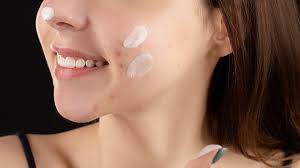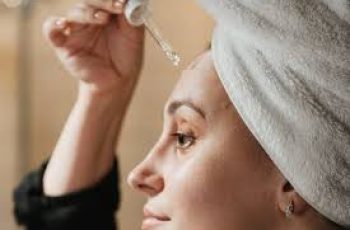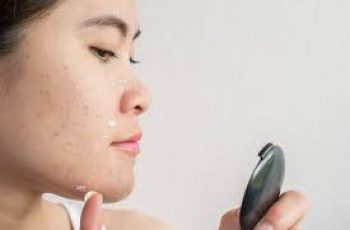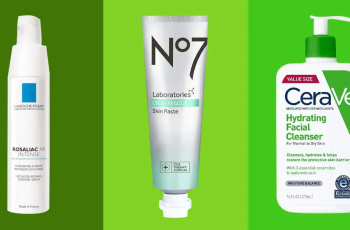.webp)
.webp)
.webp)
.webp)
Can You Use Niacinamide on Open Spots?
.webp)
.webp)
In the skincare world, few ingredients have earned the trust and attention of experts and enthusiasts quite like niacinamide. This multi-tasking vitamin has become a household name—and for good reason.
.webp)
.webp)
.webp)
As more people deal with daily skin stress, maskne (mask-induced acne), and environmental damage, ingredients that nourish, hydrate, and heal are more important than ever.
.webp)
.webp)
One question many are asking:
.webp)
.webp)
.webp)
Can you use niacinamide on open spots or pimples? Let’s explore the science and practical advice behind this powerful ingredient.
.webp)
.webp)
What Is Niacinamide?
.webp)
.webp)
.webp)
Niacinamide is a form of vitamin B3, also known as nicotinamide. It’s a water-soluble vitamin with anti-inflammatory, hydrating, and brightening properties.
.webp)
.webp)
When applied to the skin, niacinamide works to:
.webp)
.webp)
.webp)
Improve moisture retention, Strengthen the skin barrier, Reduce inflammation, Regulate oil production, Minimize pores, Fade dark spots and acne scars
.webp)
.webp)
It’s especially popular among those with acne-prone, oily, or sensitive skin, but it’s suitable for almost every skin type.
.webp)
.webp)
.webp)
What Makes Niacinamide So Special?
.webp)
.webp)
Niacinamide is gentle, yet delivers powerful results. Unlike many active ingredients, it doesn’t irritate or sting, even on sensitive skin.
.webp)
.webp)
.webp)
It’s often compared to hyaluronic acid because of its hydrating benefits. But niacinamide also controls oil production and helps reduce breakouts.
.webp)
.webp)
It also plays a role in protecting your skin from damage caused by pollution, UV rays, and other free radicals by strengthening the outer skin layer.
.webp)
.webp)
.webp)
Now, let’s focus on how this wonder ingredient works when applied to open spots or broken pimples.
.webp)
.webp)
Can You Put Niacinamide on Spots?
.webp)
.webp)
.webp)
Yes, you can absolutely apply niacinamide to spots—whether they’re fresh, healing, or already fading.
.webp)
.webp)
Niacinamide’s anti-inflammatory nature helps to:
.webp)
.webp)
.webp)
Reduce the redness and swelling of blemishes, Regulate excess sebum to prevent new breakouts, Calm irritated skin without clogging pores, Strengthen the skin’s natural defenses
.webp)
.webp)
Using niacinamide regularly can also help prevent future breakouts and reduce the chances of post-inflammatory hyperpigmentation (aka acne scars).
.webp)
.webp)
.webp)
Can You Apply Niacinamide to Open Spots or Popped Pimples?
.webp)
.webp)
Yes, you can. Niacinamide can be used on open or healing pimples, and it can support faster recovery without worsening the issue.
.webp)
.webp)
.webp)
That said, it’s worth noting that popping pimples is never ideal, as it increases the risk of infection, inflammation, and scarring. But if it happens, here’s how to treat it safely.
.webp)
.webp)
What to Do After Popping a Pimple:
.webp)
.webp)
.webp)
Wash your hands thoroughly using warm water and antibacterial soap.
.webp)
.webp)
Dab the area with a clean cotton swab to remove any leftover fluid.
.webp)
.webp)
.webp)
Use a toner with salicylic acid or glycolic acid to gently disinfect the area.
.webp)
.webp)
Apply a targeted treatment like a spot cream or gel with anti-bacterial benefits.
.webp)
.webp)
.webp)
Follow with your regular routine, avoiding irritation to the affected area.
.webp)
.webp)
The next morning, cleanse the face gently, apply vitamin C, wait 15 minutes, then follow up with niacinamide serum.
.webp)
.webp)
.webp)
This combination helps calm inflammation, protect from further breakouts, and support faster healing.
.webp)
.webp)
Can Niacinamide Be Used on Open Wounds?
.webp)
Yes, studies show that niacinamide supports wound healing. It does this by encouraging fibroblast migration and cell proliferation, both essential for repairing skin.
Niacinamide also creates a hydrated environment that keeps wounds from drying out and cracking, which slows down healing and increases discomfort.
For minor abrasions, scratches, or popped pimples, niacinamide can be a soothing and helpful step in your recovery routine.
Can Niacinamide Cause Breakouts?
Not usually. Unlike exfoliants or retinoids, niacinamide does not increase cell turnover, so it won’t cause the infamous “purging” effect.
However, in rare cases, users may see breakouts after introducing a high concentration of niacinamide (above 10%).
If this happens:
Lower your niacinamide concentration to 5% or less
Limit application to once per day
Observe your skin for 1–2 weeks to see if it improves
Most reactions to niacinamide are linked to formulas with other irritating ingredients, not niacinamide itself.
Is Niacinamide Good for Acne Scars?
Yes, niacinamide is highly effective at reducing acne scars and discoloration. With regular use, it helps fade:
Dark spots, Red acne marks, Post-inflammatory hyperpigmentation
It does this by blocking the transfer of pigment to skin cells and reducing inflammation. When paired with ingredients like salicylic acid, the combo becomes even more powerful.
Over time, niacinamide helps create a more even, radiant, and clear complexion.
Should You Use Niacinamide with Other Ingredients?
Absolutely! Niacinamide is very versatile and plays well with most actives, including:
Salicylic acid: Combats acne and clears pores
Glycolic acid: Gently exfoliates and improves skin texture
Hyaluronic acid: Enhances hydration
Vitamin C: Brightens and protects (just apply them 15 minutes apart)
Retinol: Reduces fine lines and signs of aging (start slowly)
Pairing niacinamide with the right ingredients can strengthen your routine and deliver faster, longer-lasting results.
How to Apply Niacinamide in Your Routine
Here’s how to incorporate niacinamide into your daily skincare, especially if you’re dealing with breakouts or open spots.
Morning Routine:
Gentle cleanser, Vitamin C serum (optional), Wait 15 minutes, Niacinamide serum (5–10%), Lightweight moisturizer, Broad-spectrum SPF 30 or higher
Evening Routine:
Cleanse with a mild or salicylic acid face wash, Apply targeted treatment (if needed), Use niacinamide serum, Finish with a soothing moisturizer or overnight mask
Avoid applying strong acids or retinoids to areas where the skin is broken, raw, or freshly popped. Niacinamide is a safe go-to during recovery.
Final Tips: What Else to Avoid on Open Pimples
While niacinamide is safe and calming, some products should not be applied to open or popped pimples. These include:
Benzoyl peroxide (may sting or irritate)
Alcohol-based toners (drying and harsh)
Fragrance-heavy formulas (potential allergens)
Strong retinoids or exfoliants (cause further sensitivity)
Stick to soothing, healing ingredients like:
Niacinamide, Panthenol (pro-vitamin B5), Zinc, Aloe vera, Centella asiatica
The goal is to hydrate, protect, and calm the skin, allowing the healing process to work naturally and safely.
Conclusion: Is Niacinamide Safe for Open Spots?
Yes—niacinamide is not only safe but also recommended for treating open spots, healing pimples, and fading acne scars.
With its powerful yet gentle benefits, niacinamide:
Soothes irritated or inflamed areas
Speeds up wound healing
Prevents acne scars and pigmentation
Strengthens the skin’s protective barrier
Works well with most other ingredients
For anyone struggling with breakouts, sensitivity, or scarring, niacinamide is a must-have in your skincare toolkit.
Always remember: Start slow, watch your skin, and adjust as needed. If unsure, check in with a skincare specialist or dermatologist.
Got more skincare questions? Head over to our Instagram @Procoal and drop us a message—one of our experts is always ready to help!

.webp)
.webp)
.webp)
.webp) Can You Use Niacinamide on Open Spots?
Can You Use Niacinamide on Open Spots?
.webp)
.webp) In the skincare world, few ingredients have earned the trust and attention of experts and enthusiasts quite like niacinamide. This multi-tasking vitamin has become a household name—and for good reason.
In the skincare world, few ingredients have earned the trust and attention of experts and enthusiasts quite like niacinamide. This multi-tasking vitamin has become a household name—and for good reason.
.webp)
.webp)
.webp) As more people deal with daily skin stress, maskne (mask-induced acne), and environmental damage, ingredients that nourish, hydrate, and heal are more important than ever.
As more people deal with daily skin stress, maskne (mask-induced acne), and environmental damage, ingredients that nourish, hydrate, and heal are more important than ever.
.webp)
.webp) One question many are asking:
One question many are asking:
.webp)
.webp)
.webp) Can you use niacinamide on open spots or pimples? Let’s explore the science and practical advice behind this powerful ingredient.
Can you use niacinamide on open spots or pimples? Let’s explore the science and practical advice behind this powerful ingredient.
.webp)
.webp) What Is Niacinamide?
What Is Niacinamide?
.webp)
.webp)
.webp) Niacinamide is a form of vitamin B3, also known as nicotinamide. It’s a water-soluble vitamin with anti-inflammatory, hydrating, and brightening properties.
Niacinamide is a form of vitamin B3, also known as nicotinamide. It’s a water-soluble vitamin with anti-inflammatory, hydrating, and brightening properties.
.webp)
.webp) When applied to the skin, niacinamide works to:
When applied to the skin, niacinamide works to:
.webp)
.webp)
.webp) Improve moisture retention, Strengthen the skin barrier, Reduce inflammation, Regulate oil production, Minimize pores, Fade dark spots and acne scars
Improve moisture retention, Strengthen the skin barrier, Reduce inflammation, Regulate oil production, Minimize pores, Fade dark spots and acne scars
.webp)
.webp) It’s especially popular among those with acne-prone, oily, or sensitive skin, but it’s suitable for almost every skin type.
It’s especially popular among those with acne-prone, oily, or sensitive skin, but it’s suitable for almost every skin type.
.webp)
.webp)
.webp) What Makes Niacinamide So Special?
What Makes Niacinamide So Special?
.webp)
.webp) Niacinamide is gentle, yet delivers powerful results. Unlike many active ingredients, it doesn’t irritate or sting, even on sensitive skin.
Niacinamide is gentle, yet delivers powerful results. Unlike many active ingredients, it doesn’t irritate or sting, even on sensitive skin.
.webp)
.webp)
.webp) It’s often compared to hyaluronic acid because of its hydrating benefits. But niacinamide also controls oil production and helps reduce breakouts.
It’s often compared to hyaluronic acid because of its hydrating benefits. But niacinamide also controls oil production and helps reduce breakouts.
.webp)
.webp) It also plays a role in protecting your skin from damage caused by pollution, UV rays, and other free radicals by strengthening the outer skin layer.
It also plays a role in protecting your skin from damage caused by pollution, UV rays, and other free radicals by strengthening the outer skin layer.
.webp)
.webp)
.webp) Now, let’s focus on how this wonder ingredient works when applied to open spots or broken pimples.
Now, let’s focus on how this wonder ingredient works when applied to open spots or broken pimples.
.webp)
.webp) Can You Put Niacinamide on Spots?
Can You Put Niacinamide on Spots?
.webp)
.webp)
.webp) Yes, you can absolutely apply niacinamide to spots—whether they’re fresh, healing, or already fading.
Yes, you can absolutely apply niacinamide to spots—whether they’re fresh, healing, or already fading.
.webp)
.webp) Niacinamide’s anti-inflammatory nature helps to:
Niacinamide’s anti-inflammatory nature helps to:
.webp)
.webp)
.webp) Reduce the redness and swelling of blemishes, Regulate excess sebum to prevent new breakouts, Calm irritated skin without clogging pores, Strengthen the skin’s natural defenses
Reduce the redness and swelling of blemishes, Regulate excess sebum to prevent new breakouts, Calm irritated skin without clogging pores, Strengthen the skin’s natural defenses
.webp)
.webp) Using niacinamide regularly can also help prevent future breakouts and reduce the chances of post-inflammatory hyperpigmentation (aka acne scars).
Using niacinamide regularly can also help prevent future breakouts and reduce the chances of post-inflammatory hyperpigmentation (aka acne scars).
.webp)
.webp)
.webp) Can You Apply Niacinamide to Open Spots or Popped Pimples?
Can You Apply Niacinamide to Open Spots or Popped Pimples?
.webp)
.webp) Yes, you can. Niacinamide can be used on open or healing pimples, and it can support faster recovery without worsening the issue.
Yes, you can. Niacinamide can be used on open or healing pimples, and it can support faster recovery without worsening the issue.
.webp)
.webp)
.webp) That said, it’s worth noting that popping pimples is never ideal, as it increases the risk of infection, inflammation, and scarring. But if it happens, here’s how to treat it safely.
That said, it’s worth noting that popping pimples is never ideal, as it increases the risk of infection, inflammation, and scarring. But if it happens, here’s how to treat it safely.
.webp)
.webp) What to Do After Popping a Pimple:
What to Do After Popping a Pimple:
.webp)
.webp)
.webp) Wash your hands thoroughly using warm water and antibacterial soap.
Wash your hands thoroughly using warm water and antibacterial soap.
.webp)
.webp) Dab the area with a clean cotton swab to remove any leftover fluid.
Dab the area with a clean cotton swab to remove any leftover fluid.
.webp)
.webp)
.webp) Use a toner with salicylic acid or glycolic acid to gently disinfect the area.
Use a toner with salicylic acid or glycolic acid to gently disinfect the area.
.webp)
.webp) Apply a targeted treatment like a spot cream or gel with anti-bacterial benefits.
Apply a targeted treatment like a spot cream or gel with anti-bacterial benefits.
.webp)
.webp)
.webp) Follow with your regular routine, avoiding irritation to the affected area.
Follow with your regular routine, avoiding irritation to the affected area.
.webp)
.webp) The next morning, cleanse the face gently, apply vitamin C, wait 15 minutes, then follow up with niacinamide serum.
The next morning, cleanse the face gently, apply vitamin C, wait 15 minutes, then follow up with niacinamide serum.
.webp)
.webp)
.webp) This combination helps calm inflammation, protect from further breakouts, and support faster healing.
This combination helps calm inflammation, protect from further breakouts, and support faster healing.
.webp)
.webp) Can Niacinamide Be Used on Open Wounds?
Can Niacinamide Be Used on Open Wounds?
.webp) Yes, studies show that niacinamide supports wound healing. It does this by encouraging fibroblast migration and cell proliferation, both essential for repairing skin.
Niacinamide also creates a hydrated environment that keeps wounds from drying out and cracking, which slows down healing and increases discomfort.
For minor abrasions, scratches, or popped pimples, niacinamide can be a soothing and helpful step in your recovery routine.
Can Niacinamide Cause Breakouts?
Not usually. Unlike exfoliants or retinoids, niacinamide does not increase cell turnover, so it won’t cause the infamous “purging” effect.
However, in rare cases, users may see breakouts after introducing a high concentration of niacinamide (above 10%).
If this happens:
Lower your niacinamide concentration to 5% or less
Limit application to once per day
Observe your skin for 1–2 weeks to see if it improves
Most reactions to niacinamide are linked to formulas with other irritating ingredients, not niacinamide itself.
Is Niacinamide Good for Acne Scars?
Yes, niacinamide is highly effective at reducing acne scars and discoloration. With regular use, it helps fade:
Dark spots, Red acne marks, Post-inflammatory hyperpigmentation
It does this by blocking the transfer of pigment to skin cells and reducing inflammation. When paired with ingredients like salicylic acid, the combo becomes even more powerful.
Over time, niacinamide helps create a more even, radiant, and clear complexion.
Should You Use Niacinamide with Other Ingredients?
Absolutely! Niacinamide is very versatile and plays well with most actives, including:
Salicylic acid: Combats acne and clears pores
Glycolic acid: Gently exfoliates and improves skin texture
Hyaluronic acid: Enhances hydration
Vitamin C: Brightens and protects (just apply them 15 minutes apart)
Retinol: Reduces fine lines and signs of aging (start slowly)
Pairing niacinamide with the right ingredients can strengthen your routine and deliver faster, longer-lasting results.
How to Apply Niacinamide in Your Routine
Here’s how to incorporate niacinamide into your daily skincare, especially if you’re dealing with breakouts or open spots.
Morning Routine:
Gentle cleanser, Vitamin C serum (optional), Wait 15 minutes, Niacinamide serum (5–10%), Lightweight moisturizer, Broad-spectrum SPF 30 or higher
Evening Routine:
Cleanse with a mild or salicylic acid face wash, Apply targeted treatment (if needed), Use niacinamide serum, Finish with a soothing moisturizer or overnight mask
Avoid applying strong acids or retinoids to areas where the skin is broken, raw, or freshly popped. Niacinamide is a safe go-to during recovery.
Final Tips: What Else to Avoid on Open Pimples
While niacinamide is safe and calming, some products should not be applied to open or popped pimples. These include:
Benzoyl peroxide (may sting or irritate)
Alcohol-based toners (drying and harsh)
Fragrance-heavy formulas (potential allergens)
Strong retinoids or exfoliants (cause further sensitivity)
Stick to soothing, healing ingredients like:
Niacinamide, Panthenol (pro-vitamin B5), Zinc, Aloe vera, Centella asiatica
The goal is to hydrate, protect, and calm the skin, allowing the healing process to work naturally and safely.
Conclusion: Is Niacinamide Safe for Open Spots?
Yes—niacinamide is not only safe but also recommended for treating open spots, healing pimples, and fading acne scars.
With its powerful yet gentle benefits, niacinamide:
Soothes irritated or inflamed areas
Speeds up wound healing
Prevents acne scars and pigmentation
Strengthens the skin’s protective barrier
Works well with most other ingredients
For anyone struggling with breakouts, sensitivity, or scarring, niacinamide is a must-have in your skincare toolkit.
Always remember: Start slow, watch your skin, and adjust as needed. If unsure, check in with a skincare specialist or dermatologist.
Got more skincare questions? Head over to our Instagram @Procoal and drop us a message—one of our experts is always ready to help!
Yes, studies show that niacinamide supports wound healing. It does this by encouraging fibroblast migration and cell proliferation, both essential for repairing skin.
Niacinamide also creates a hydrated environment that keeps wounds from drying out and cracking, which slows down healing and increases discomfort.
For minor abrasions, scratches, or popped pimples, niacinamide can be a soothing and helpful step in your recovery routine.
Can Niacinamide Cause Breakouts?
Not usually. Unlike exfoliants or retinoids, niacinamide does not increase cell turnover, so it won’t cause the infamous “purging” effect.
However, in rare cases, users may see breakouts after introducing a high concentration of niacinamide (above 10%).
If this happens:
Lower your niacinamide concentration to 5% or less
Limit application to once per day
Observe your skin for 1–2 weeks to see if it improves
Most reactions to niacinamide are linked to formulas with other irritating ingredients, not niacinamide itself.
Is Niacinamide Good for Acne Scars?
Yes, niacinamide is highly effective at reducing acne scars and discoloration. With regular use, it helps fade:
Dark spots, Red acne marks, Post-inflammatory hyperpigmentation
It does this by blocking the transfer of pigment to skin cells and reducing inflammation. When paired with ingredients like salicylic acid, the combo becomes even more powerful.
Over time, niacinamide helps create a more even, radiant, and clear complexion.
Should You Use Niacinamide with Other Ingredients?
Absolutely! Niacinamide is very versatile and plays well with most actives, including:
Salicylic acid: Combats acne and clears pores
Glycolic acid: Gently exfoliates and improves skin texture
Hyaluronic acid: Enhances hydration
Vitamin C: Brightens and protects (just apply them 15 minutes apart)
Retinol: Reduces fine lines and signs of aging (start slowly)
Pairing niacinamide with the right ingredients can strengthen your routine and deliver faster, longer-lasting results.
How to Apply Niacinamide in Your Routine
Here’s how to incorporate niacinamide into your daily skincare, especially if you’re dealing with breakouts or open spots.
Morning Routine:
Gentle cleanser, Vitamin C serum (optional), Wait 15 minutes, Niacinamide serum (5–10%), Lightweight moisturizer, Broad-spectrum SPF 30 or higher
Evening Routine:
Cleanse with a mild or salicylic acid face wash, Apply targeted treatment (if needed), Use niacinamide serum, Finish with a soothing moisturizer or overnight mask
Avoid applying strong acids or retinoids to areas where the skin is broken, raw, or freshly popped. Niacinamide is a safe go-to during recovery.
Final Tips: What Else to Avoid on Open Pimples
While niacinamide is safe and calming, some products should not be applied to open or popped pimples. These include:
Benzoyl peroxide (may sting or irritate)
Alcohol-based toners (drying and harsh)
Fragrance-heavy formulas (potential allergens)
Strong retinoids or exfoliants (cause further sensitivity)
Stick to soothing, healing ingredients like:
Niacinamide, Panthenol (pro-vitamin B5), Zinc, Aloe vera, Centella asiatica
The goal is to hydrate, protect, and calm the skin, allowing the healing process to work naturally and safely.
Conclusion: Is Niacinamide Safe for Open Spots?
Yes—niacinamide is not only safe but also recommended for treating open spots, healing pimples, and fading acne scars.
With its powerful yet gentle benefits, niacinamide:
Soothes irritated or inflamed areas
Speeds up wound healing
Prevents acne scars and pigmentation
Strengthens the skin’s protective barrier
Works well with most other ingredients
For anyone struggling with breakouts, sensitivity, or scarring, niacinamide is a must-have in your skincare toolkit.
Always remember: Start slow, watch your skin, and adjust as needed. If unsure, check in with a skincare specialist or dermatologist.
Got more skincare questions? Head over to our Instagram @Procoal and drop us a message—one of our experts is always ready to help!



